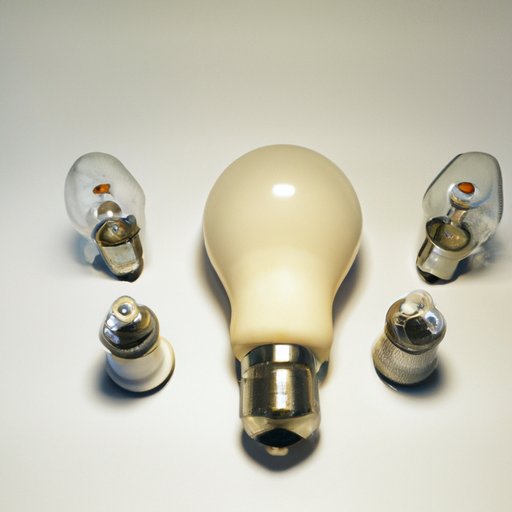Introduction
A light bulb is a device that produces visible light when electric current passes through it. It consists of an electric element, usually a thin wire, which is heated until it glows or emits light. The purpose of this article is to provide an in-depth exploration of how light bulbs work, from understanding the physics behind electricity to exploring the different types of light bulbs and their applications in modern life.

Explaining the Physics Behind How a Light Bulb Works
To understand how a light bulb works, we must first understand the physics behind electricity. Electricity is a form of energy created by the movement of electrons. When electrons move through a conductor, like a wire, they create an electrical current. This electrical current is then converted into different forms of energy, such as heat, light, or sound.
The process of converting electrical energy to light energy is called incandescence. In a light bulb, the electrical current passes through a thin filament, which is heated until it starts to glow. The glowing filament is what produces the visible light. The amount of light produced depends on the type of filament used and the amount of current passing through it.
A Step-by-Step Guide to Understanding the Inner Workings of a Light Bulb
Let’s take a closer look at the components of a light bulb and how they function together. The main components of a light bulb are the filament, the base and socket, and the bulb envelope.
Breaking Down the Components of a Light Bulb and Their Function
The filament is the most important part of a light bulb. It is a thin wire made of tungsten that is heated to very high temperatures when an electrical current passes through it. This causes the filament to emit light. The base and socket provide a connection between the filament and the power source. The bulb envelope is a glass or plastic container that encloses the filament and protects it from air and moisture.

How Different Types of Light Bulbs Work
There are several different types of light bulbs available today, each with its own unique properties and advantages. Incandescent bulbs are the most common type of light bulb, and they produce light by passing an electrical current through a filament. Fluorescent bulbs use a gas-filled tube to produce light, while LED bulbs use semiconductor chips to convert electrical energy into light energy.
Examining the Electrical System of a Light Bulb
In order for a light bulb to work, an electrical circuit must be completed. This means that there must be a complete path for the current to flow from the power source, through the filament, and back to the power source. The flow of current is controlled by a switch, which can be turned on and off to control the amount of current flowing through the filament.

The History of Light Bulbs and How They Got to be What They Are Today
The invention of the light bulb was an important milestone in human history. The first light bulb was invented in 1879 by Thomas Edison, and it was made of a carbon filament enclosed in a vacuum-sealed glass bulb. Since then, the light bulb has undergone many changes and improvements, leading to the modern light bulbs we have today.
Looking at the Various Applications of Light Bulbs in Modern Life
Light bulbs are used in a variety of applications in modern life. Home lighting is one of the most common uses of light bulbs, and they are also used in industrial settings to provide bright, consistent lighting. Automotive lighting is another popular application, as light bulbs are used to illuminate headlights, taillights, and turn signals.
Conclusion
In conclusion, this article has provided an in-depth exploration of how light bulbs work. We have looked at the physics behind electricity and explored the different components of a light bulb and how they work together. We have also examined the different types of light bulbs and their applications in modern life. Finally, we have taken a look at the history of light bulbs and how they got to be what they are today.
(Note: Is this article not meeting your expectations? Do you have knowledge or insights to share? Unlock new opportunities and expand your reach by joining our authors team. Click Registration to join us and share your expertise with our readers.)
